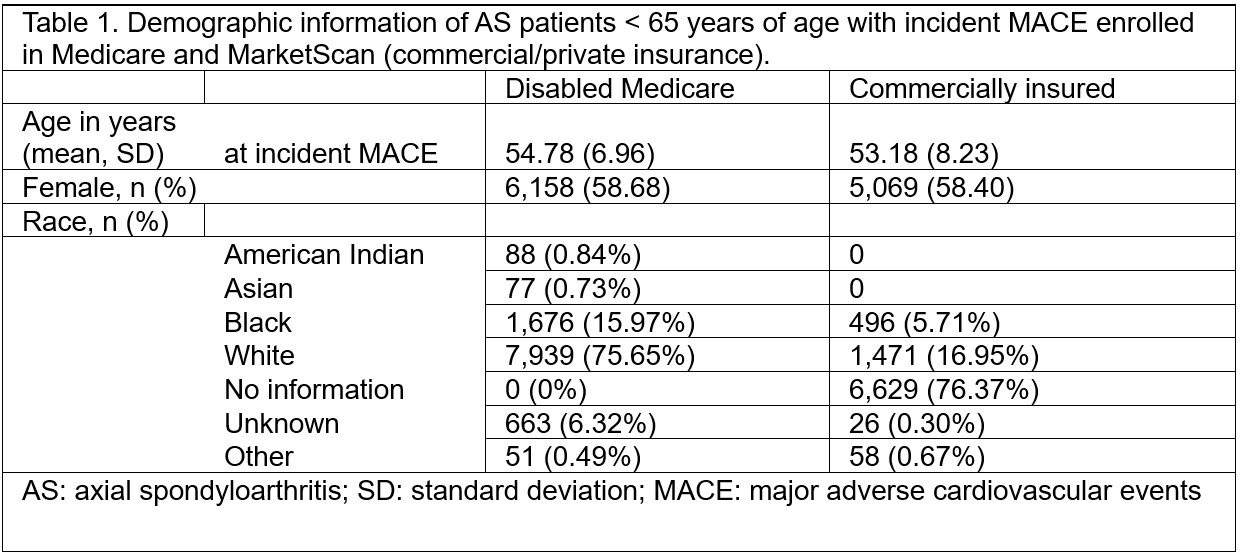Session Information
Session Type: Poster Session B
Session Time: 9:00AM-11:00AM
Background/Purpose: AS is an inflammatory disorder of the axial skeleton and can cause complications including disabling joint damage. Nearly 20% of people with AS are on Medicare disability insurance1. Major adverse cardiovascular events (MACE) are the leading cause of death in AS2. Despite the high prevalence of disability in AS, these patients are understudied1 and may be different than similarly aged commercially insured patients. We sought to compare MACE incidence temporal trends in AS patients who are beneficiaries of Medicare disability insurance against those with commercial insurance in order to understand the excess risk for CVD events in disabled patients.
Methods: We conducted a retrospective longitudinal analysis from 2007-2019 using the Medicare Fee-for-Service and MarketScan claims databases. Subjects were identified by having ≥ 2 AS International Classification of Diseases (ICD)-9/10 diagnosis codes in outpatient visits with age between 18 and 64 years. MACE was defined as an incident hospitalized myocardial infarction or ischemic stroke and identified by validated ICD 9/10 diagnosis codes. Patients with prior MACE were excluded3. We reported demographics, cumulative raw incidence/1000 person and determined incidence rate ratios for disabled Medicare enrollees versus commercially insured AS patients. We displayed incidence trends and calculated yearly annual percentage change (APC) based off end-of-year cutpoints; significance was determined using the Monte Carlo Permutations method. SAS v9.4 and Joinpoint Trend Analysis v5.0 software were used for analyses; p < 0.05 determined statistical significance.
Results: The total number of AS patients eligible for analysis was 1,097,297 from Medicare and 2,258,212 from MarketScan. Incident MACE was identified in 10,494 subjects in Medicare and 8,860 individuals in MarketScan. The mean age in years at which MACE occurred was 54.8 and 53.3 in patients with Medicare and MarketScan, respectively. Most patients with MACE were female and White (Table 1). In the disabled Medicare cohort, the incidence of MACE ranged from 7.7-11.5/1000 patients. This cohort showed a significant decrease in incidence from 2007-2014 (-4.1 APC), then a significant increase from 2014-2017 (14.0 APC), then no significant difference from 2017-2019 (Figure 2b). In the MarketScan cohort, the incidence of MACE was between 3.2-4.7/1000 patients and there was a non-significant upward trend (3.4 APC) in the MACE incidence rate (Figure 1c). The incidence rate ratio compared disabled Medicare enrollees with AS to commercially insured AS patients ranged from 2.2-3 (Table 2).
Conclusion: Disabled AS patients younger than age 65 years with Medicare experienced a 2-3-fold higher incidence of MACE compared to younger commercially insured patients; unexpectedly, the group of AS patients experiencing MACE events was made up of a high percentage of women. Incidence trend for MACE differed for both groups and did show signs of increase, though not significant. Our future research is to understand why there is a difference between the groups, including differences in the prevalence comorbidities, socioeconomic status, treatment patterns, and healthcare access.
To cite this abstract in AMA style:
Sen R, Leach J, Danila M, Xie F, Singh J, Caplan L, Navarro-Millán I, Curtis J. Temporal Trends in Cardiovascular Events in Axial Spondyloarthritis Patients with Medicare Insurance versus Commercial Insurance: An Analysis Using Claims Data [abstract]. Arthritis Rheumatol. 2023; 75 (suppl 9). https://acrabstracts.org/abstract/temporal-trends-in-cardiovascular-events-in-axial-spondyloarthritis-patients-with-medicare-insurance-versus-commercial-insurance-an-analysis-using-claims-data/. Accessed .« Back to ACR Convergence 2023
ACR Meeting Abstracts - https://acrabstracts.org/abstract/temporal-trends-in-cardiovascular-events-in-axial-spondyloarthritis-patients-with-medicare-insurance-versus-commercial-insurance-an-analysis-using-claims-data/



